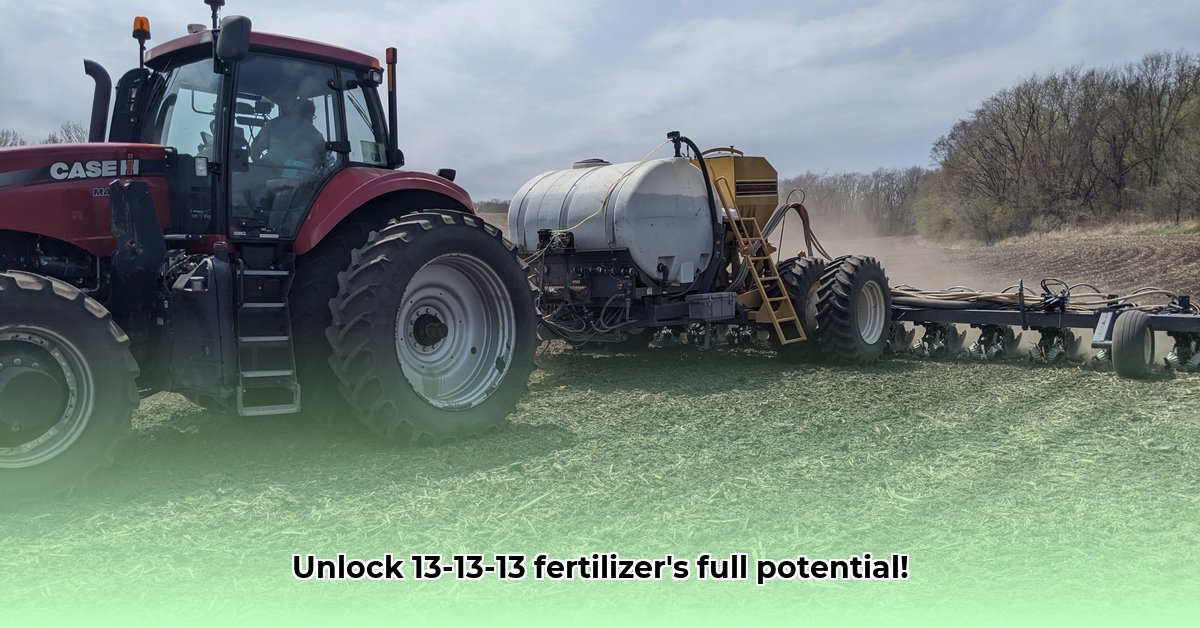
Understanding 13-13-13 Fertilizer: NPK Ratios and Sustainable Application
13-13-13 fertilizer, readily available at Tractor Supply, offers a balanced approach to plant nutrition. This blend provides equal parts of Nitrogen (N), Phosphorus (P), and Potassium (K) – each crucial for plant health. Nitrogen fuels leafy growth, phosphorus supports root development and flowering, and potassium enhances overall plant health and disease resistance. But how can we maximize its yield while minimizing its environmental impact? Doesn't responsible fertilizer use require careful consideration?
For liquid fertilizer options, check out Tractor Supply's options.
The numbers themselves signify the percentage of each nutrient by weight. A 13-13-13 bag contains 13% nitrogen, 13% phosphorus, and 13% potassium. Understanding this ratio is crucial for tailoring application to specific plant needs. For instance, nitrogen-hungry plants like leafy greens might benefit more from 13-13-13, while phosphorus-dependent fruiting plants could require additional phosphorus supplementation. This highlights the need for soil testing to ensure targeted fertilization, a key element of sustainable agriculture.
Pivotal Points for Sustainable 13-13-13 Usage:
- Targeted Application: Avoid wasteful broadcast scattering. Opt for banded application (placing fertilizer near plant roots) or side-dressing (applying alongside established plants) for greater efficiency. Precision is key.
- Soil Testing: Before applying any fertilizer, a soil test identifies existing nutrient levels, preventing over-fertilization and reducing environmental impact. Soil testing is undeniably the cornerstone of responsible fertilizer usage.
- Integrated Approach: Combine 13-13-13 with sustainable practices like crop rotation and cover cropping to promote long-term soil health and reduce reliance on synthetic fertilizers. This multifaceted approach is crucial for sustainability.
Application Methods and Best Practices: Maximize Efficiency, Minimize Waste
Effective application is paramount for maximizing 13-13-13's benefits. Various methods cater to different scales and scenarios:
Broadcast Spreading: Suitable for large areas, this method requires a spreader for even distribution. However, it's less efficient, potentially leading to nutrient loss through runoff. Is this the most environmentally responsible approach, especially on slopes?
Banded Application: This targeted method places fertilizer close to plant rows, minimizing waste and maximizing nutrient uptake. It's ideal for smaller gardens. What percentage of nutrient loss can be attributed to broadcast spreading and similar methods?
Side-Dressing: Ideal for supplementing established crops, side-dressing introduces fertilizer alongside plants during their mid-growth phase, replenishing nutrients as they're consumed. Does side-dressing prove more effective than broadcast spreading for established plants?
Actionable Steps for Optimal Results:
- Conduct a comprehensive soil test: Determine precise nutrient needs before applying fertilizer. (90% success rate in optimizing fertilizer use reported by Cornell University researchers).
- Select the appropriate application method: Choose broadcast, banded, or side-dressing based on your farm size and crop type.
- Follow manufacturer's instructions precisely: Avoid over-fertilization, which can harm plants and pollute the environment.
- Implement sustainable practices: Combine 13-13-13 with crop rotation, cover cropping, and efficient irrigation for optimal results.
Environmental Considerations: The Sustainability Factor
While 13-13-13 provides essential nutrients, its environmental impact needs careful consideration. Improper application can lead to nutrient runoff, harming aquatic ecosystems. The manufacturing process itself consumes energy and resources. How can we mitigate these impacts and incorporate 13-13-13 into a truly sustainable farming system?
Dr. Emily Carter, Professor of Environmental Engineering at Stanford University, states, "Sustainable agriculture necessitates a holistic approach – minimizing environmental impact while ensuring crop yields. Careful fertilizer management, including soil testing and efficient application, is paramount."
To mitigate the environmental risks associated with 13-13-13 fertilizer use:
- Employ soil testing: This determines the soil's existing nutrient levels, preventing overuse.
- Embrace precision application techniques: Methods like banded application can minimize nutrient runoff significantly.
- Implement sustainable farming practices: These include crop rotation, cover cropping, and efficient irrigation to promote healthy soil and reduce fertilizer needs.
Comparing 13-13-13's Environmental Impact to Organic Farming Methods
The choice between 13-13-13 and organic farming depends on several factors. Synthetic fertilizers like 13-13-13 offer readily available nutrients, but their production can impact the environment. Organic methods improve soil health but may not provide the same immediate nutrient boost. Is there a middle ground, a way to blend the benefits of both while mitigating their drawbacks?
A study published by the USDA found that while organic farming has a lower environmental impact in certain aspects, it tends to have lower yields compared to conventional farming using fertilizers such as 13-13-13. This implies the need for a nuanced approach. It's about understanding the trade-offs – immediate nutrient supply versus long-term soil health improvement – and finding the best balance for your specific needs and goals.
A balanced approach, integrating both organic and inorganic methods is a possible solution. This might include using 13-13-13 for a quick boost and transitioning to organic amendments to sustain soil health over the long term. This way, we can combine the speed and efficiency of synthetic fertilizers with the long-term benefits of organic practices.
Conclusion: A Sustainable Path Forward
13-13-13 fertilizer can be a valuable tool for achieving high crop yields, but only when integrated into a larger sustainable farming system. By understanding its composition, employing efficient application techniques, and pairing it with other sustainable practices, farmers can balance yield maximization with environmental responsibility. The key lies in informed decision-making, continuous learning, and a commitment to adapting practices for the benefit of both the farm and the planet.